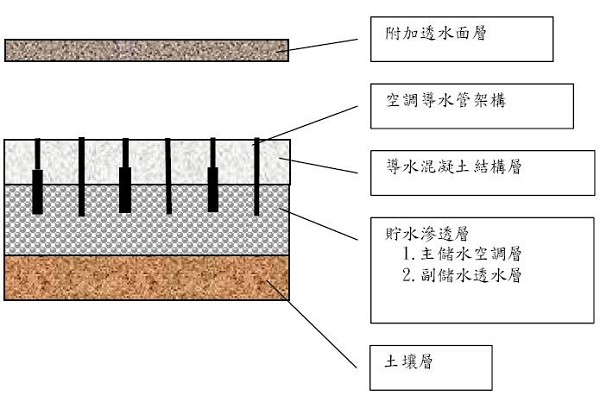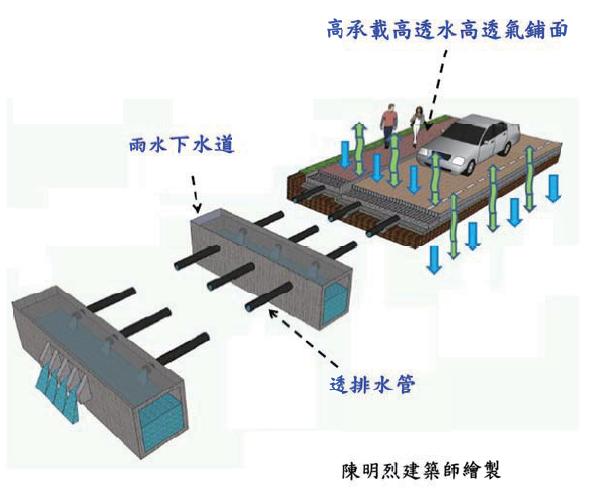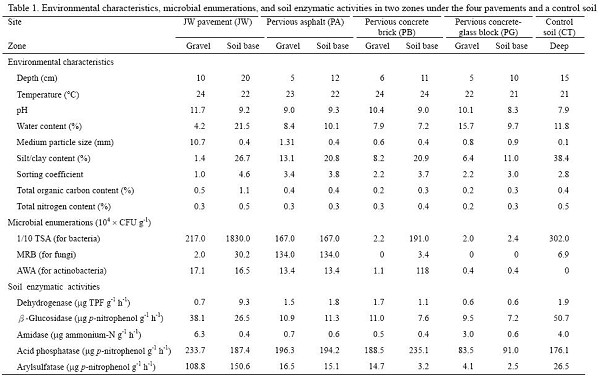Expert Study
Just when Mr. Jui-Wen was about to start promoting the JW Eco-Technology on his own, he received a phone call from Professor Xian-De Lin of the Architecture Department at the National Cheng Kung University. Professor Lin invited Mr. Chen to join the Green Magic School building project. Today, we can see that the road in front of the Green Magic School was built using the JW Eco-Technology. Professor Lin has personally witnessed the features of the JW methods. He discovered that the compressive strength of the JW Pavement was as high as 510~1980 kgf/cm2 and its water infiltration rate was 200 mm/hr. Underneath the JW Pavement, the roots of plants could grow in any direction, and even earthworms and microorganisms could live peacefully. Therefore, Professor Lin referred to the JW Pavement as a road that is a giant breathing forest that is durable enough to hold a tank and permeable as the sand on the beach.
This collaboration with Professor Lin inspired Mr. Jui-Wen Chen to promote his JW Eco-Technology by working with scholars and their research studies. Thus, more and more research articles appeared on the topic of Mr. Jui-Wen Chen’s invention.
In July 2006, Mr. Jui-Wen Chen collaborated with the water expert Professor Ming-Chee Wu. Together, they published the article “Structural Pervious Pavement to Sustainable Groundwater Resources and Eco-environmental Conservation.” This research article revealed that the JW Eco-Technology can prevent flood and drought, regulate climate, conserve soil, reduce pollution, recycle rainwater, etc.

In January 2012, Mr. Jui-Wen Chen worked with Professor Chung-Ming Liu, an expert on climate change and atmospheric sciences. The two of them published an article in the Journal of the Air & Waste Management Association in the United States titled “A Study on the Effect of Hydraulic-conductivity JW Pavement on Diluting Air Pollutants Emitted from Vehicles.” This article confirmed that 20 minutes after the release of car exhaust, the JW Eco-Technology can capture 58~97% of the air pollutants. Underneath the JW Pavement, the pH level of water is above 11, and evidence shows a rich activity of microorganisms and bacteria. This leads to the conclusion that air pollutants are absorbed or diluted into the groundwater or gravel as well as the surface of the soil; it is then decomposed into microorganisms and act as nutrient for the surrounding ecological life. It is because of this process of absorbing pollutants, decomposing them through soil, and turning the once polluted air into fresh air that the JW Eco-Technology Pavement got its other name – the breathing road.

In the 2013 Cross-Strait Hydropower Technology Seminar, Professor Chung-Ming Liu, an expert in atmospheric sciences, and Professor Ying-Shih Hsieh, an expert in environmental quality, worked together with Mr. Jui-Wen Chen on an article titled “In Response to Extreme Weather–Building a Sponge City.” In this article, they discussed how a sponge city created by the JW Eco-Technology may be a possible solution in dealing with current extreme weather conditions, such as sudden downpours, drought, and heat waves.
In that same article, it was mentioned that it is only through replacing all non-permeable roads with permeable roads can there be a surface area large enough for all the water to infiltrate into an underground water detention basin. During the heat of the summertime, the water that had been stored can evaporate into the air and lower the high temperature caused by the heat island effect. In addition, creating an underground wetland can allow an increase in ecological surfaces within the city. Furthermore, the article also stated that the sponge-like pavement used to create a sponge city must have the following features: high load-bearing capacity; high water infiltration capacity; high water-storing capabilities; highly permeable; cost-effective; and long-lasting. Currently, the only type of permeable pavement possessing all of these qualities is the JW Eco-Technology Pavement. Therefore, the name “sponge road” eventually came to be used to refer to the JW Pavement.

In March 2014, Mr. Jui-Wen Chen collaborated with microbiologist Lan-Feng Fan and Professor Si-Fu Wang. Together, they published an article titled “Performance Evaluation of Microbial Compositions and Activities of JW and Three Other Pavements” in the Journal of Environmental Engineering. The article mainly compares and assesses soil characteristics with regard to their microbial structures and activities under different pervious pavements. The study shows the soil under the JW Eco-Technology Pavement allows the growth of a variety of microbes and supports active microbial metabolism more so than the other types of pervious pavement. The results are due to the looser soil structure, higher moisture level, and higher total organic carbon content under the JW Pavement. These soil characteristics can be attributed to the design of the Aqueduct Assembly. Unlike traditional pavements that block airflow between the earth and living organisms, the Aqueduct Assembly allows air to circulate freely and, once again, allows a healthy air-circulation in the atmosphere needed for the earth’s living organisms to flourish.

One article after another on the JW Eco-Technology, they all prove that this unique eco-technology is effective based on scientific studies. Soon, names like “the breathing road” and the “sponge road” came to be synonymous with the JW Eco-Technology.
By Diane Wang